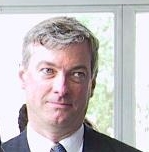

|
| Photo courtesy of Simon Moore |
My research interests have been in computer networks and operating systems - particularly in respect of performance guarantees. More recently I have focused on the use of information systems to reduce energy demand. This has resulted in two differnent campaigns.
One is about making energy information more readily available - public availability of raw information and tools that can interpret such information and trying to drive down the cost of fine-grain electricity monitoring. The first is perhaps best seen at the Gates Building energy visualistion (click on the nodes on the tree at the left to get started), the second here. The low cost monitors are now being piloted in the Department of Pathology at Cambridge. The same visualisation tool can be used to look at this information - currently rather nascent - at the Pathology energy page.
The visualisation tool(s) are being worked on and the more important point is that the information used by the tools is publicly available; anyone may develop tools to process the data in better ways. I hope to have animated sankey diagrams later in the year.
The other is a dual realisation that (i) we lack information on occupant behaviour that we might use to contextualise energy use, and (ii) that the way we distribute power for lighting is badly out-of-date. Tbese seemingly disconnected notions jointly give rise to a DC powered lighting and sensor networ. More details to come, but the key ideas are a 24VDC network, battery backed up, easy to integrate renewables (particularly solar), convenient power for processors and sensors (and LEDs), much higher reliability, much more efficient, open platform - not just about lighting, long component lifetime so processor for every light is sensible, drastic reduction in emergency lighting cost, etc. As you can see from the Gates Building energy visualisation, 20% of our electricity use is on lights. We have a single corridor on a DC network with LED lighting that reduces the energy by about a factor of ten. The computer science starts when we begin to gather information from the sensors co-located with the lights. More can be found here.
From 1999 to 2004, I was Head of the Computer Laboratory, and from January 2004 to 2009 I was the University's Pro-Vice-Chancellor for Research. The PVC job involved co-ordinating research policy (including IPR!), providing the academic oversight of
the handling of research grants and contracts, interacting with industrial
sponsors and interacting with UK government on research and third stream
funding.
I have taught courses in communications, introductory hardware design and computer systems modelling.
Since 1985 I have been a Fellow of Christ's College, and until 2002 was Director of Studies in Computer Science at Christ's. (I was be Director of Studies again in 2011-12.)
I did my undergraduate work in Engineering Science (CS Option) at the University of Toronto finishing in 1977. I then did a one year Masters at Toronto in Electrical Engineering and then a PhD at the University of Cambridge Computer Laboratory which I finished in 1983.I stayed on at the Computer Laboratory and have been involved in networking/operating system research ever since. I have supervised about 25 completed PhDs.
I was a co-founder of Nemesys Research Limited which exploited the results of research work done in the department, producing hardware and software to allow cost effective video connection to ATM networks. Nemesys was acquired in 1996 by FORE Systems. I later cofounded CPlane Inc which exploited other work in the Department concerned with network control.
Two photos , one from opening of the Gates Building, one from Intel Lab opening.